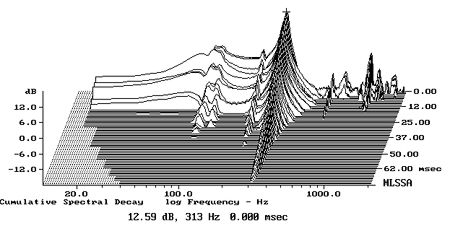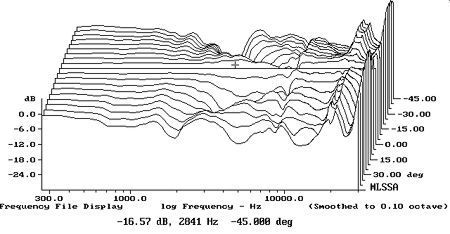| Columns Retired Columns & Blogs |
Infinity Primus 150 loudspeaker Measurements
Sidebar 3: Measurements
A fundamental choice faces every designer of small speakers: extend the low-frequency performance but accept a low sensitivity, or maximize sensitivity and live with the curtailed bass response? The Primus 150's designer has chosen the latter course; while Bob Reina noted its lightweight bass in his auditioning, the speaker offers above-average sensitivity, at an estimated 89.5dB(B)/2.83V/m. In addition, its impedance is also fairly amplifier-friendly, remaining above 5 ohms for most of the bass, mid, and treble ranges (fig.1). The impedance magnitude does drop to 3.9 ohms above the audioband, but this will not be a problem, given the low amount of energy in music at this frequency, particularly with CD playback.

Fig.1 Infinity Primus 150, electrical impedance (solid) and phase (dashed). (2 ohms/vertical div.)
The slight wrinkle that can be seen in the impedance traces at 300Hz implies the presence of a resonant mode of some kind in this region. When I examined the cabinet's vibrational behavior with a simple accelerometer, I did find a very strong mode present on all surfaces (fig.2), but it was a little higher in frequency at 313Hz. BJR noticed no lower-midrange coloration that could be laid at the feet of this mode, but such high-Q resonances can often "hide between the cracks" with some kinds of music. However, as the frequency of the E-flat above Middle C is 309Hz, I would have expected this cabinet mode to be excited at least some of the time. Hit play on the sound file below to hear the cabinet resonance.

Fig.2 Infinity Primus 150, cumulative spectral-decay plot calculated from the output of an accelerometer fastened to the cabinet's side panel (MLS driving voltage to speaker, 7.55V; measurement bandwidth, 2kHz).
The saddle at 70Hz in the impedance-magnitude plot indicates the tuning of the Infinity's reflex port. The expected notch in the woofer's nearfield response plot (fig.3, blue trace) occurs slightly higher in frequency, at 74Hz, while the peak in the port's output (fig.3, red trace) is higher still: between 80Hz and 90Hz. The complex sum of the woofer and port outputs (fig.3, black trace below 300Hz) peaks up a little, but this will be almost entirely due to the nearfield measurement technique. The Primus 150 does roll off rapidly below 80Hz.

Fig.3 Infinity Primus 150, anechoic response on tweeter axis at 50", averaged across 30 degrees horizontal window and corrected for microphone response, with the nearfield responses of the woofer and port and their complex sum, taking into account acoustic phase and distance from the nominal farfield point, plotted below 300Hz, 1kHz, and 300Hz.
Note the sharp peak in the port's output at 800Hz. This might be low enough in level to be inaudible, but the farfield response (fig.3, black trace above 300Hz) also has a slight peak evident, which suggests that something is going on at this frequency. The midrange is shelved down slightly in this graph compared with the treble, which, along with the slight but broad peak in the presence region, might help with the speaker's presentation of recorded detail. But other than those two features, the Infinity's response is extraordinarily flat, overall.
Whether or not a speaker with a flat on-axis response is perceived as neutrally balanced in a given room will depend on its dispersion. The Primus 150's lateral dispersion (fig.4) is wide and even, even in the top audio octave. Nor is there any trace of the usual off-axis flare at the bottom of the tweeter's passband. All things being equal, this behavior suggests that the Infinity will sound relatively neutrally balanced, and that its stereo imaging will be stable and well-defined (though the resonances at 313Hz and 800Hz that I mentioned earlier might "pull" images at these frequencies to the sides). In the vertical plane (fig.5), the Infinity's balance remains neutral 5 degrees above and below the tweeter axis, but large suckouts develop in the crossover region at greater off-axis angles. High stands will work better than low ones if the speaker is not to sound a little hollow.

Fig.4 Infinity Primus 150, lateral response family at 50", normalized to response on tweeter axis, from back to front: differences in response 90 degrees-5 degrees off-axis, reference response, differences in response 5 degrees-90 degrees off-axis.

Fig.5 Infinity Primus 150, vertical response family at 50", normalized to response on tweeter axis, from back to front: differences in response 45 degrees-5 degrees above axis, reference response, differences in response 5 degrees-45 degrees below axis.
The Primus 150's step response (fig.6) reveals that both drive-units are connected with the same, positive, acoustic polarity. While the slight resonant mode at 8.6kHz might add just a touch of wiriness at high levels, the Infinity's cumulative spectral-decay plot (fig.7) is otherwise very clean.

Fig.6 Infinity Primus 150, step response on tweeter axis at 50" (5ms time window, 30kHz bandwidth).

Fig.7 Infinity Primus 150, cumulative spectral-decay plot at 50" (0.15ms risetime).
Although I was a little bothered by its midrange resonances, the Primus 150's overall measured performance is excellent, considering the Chinese-made speaker's bargain price.—John Atkinson
- Log in or register to post comments




































